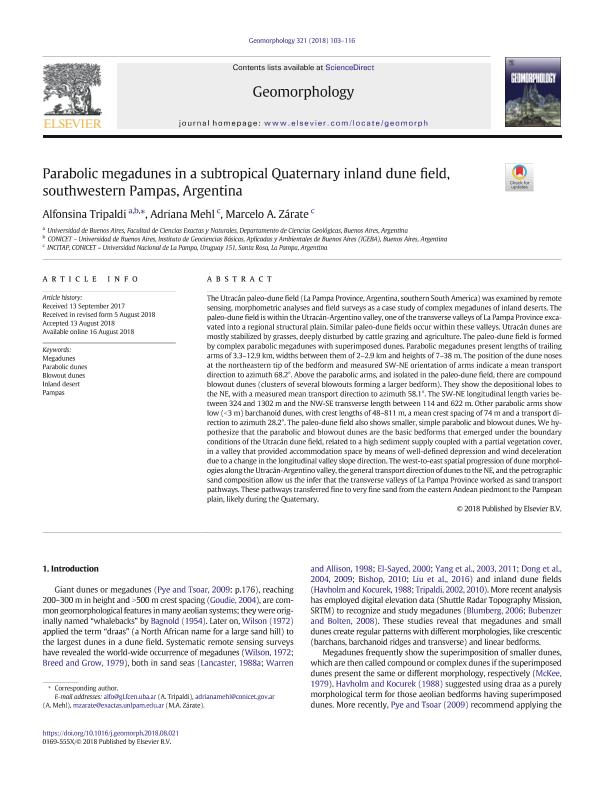Artículo
Parabolic megadunes in a subtropical Quaternary inland dune field, southwestern Pampas, Argentina
Fecha de publicación:
11/2018
Editorial:
Elsevier Science
Revista:
Geomorphology
ISSN:
0169-555X
Idioma:
Inglés
Tipo de recurso:
Artículo publicado
Clasificación temática:
Resumen
The Utracán paleo-dune field (La Pampa Province, Argentina, southern South America) was examined by remote sensing, morphometric analyses and field surveys as a case study of complex megadunes of inland deserts. The paleo-dune field is within the Utracán-Argentino valley, one of the transverse valleys of La Pampa Province excavated into a regional structural plain. Similar paleo-dune fields occur within these valleys. Utracán dunes are mostly stabilized by grasses, deeply disturbed by cattle grazing and agriculture. The paleo-dune field is formed by complex parabolic megadunes with superimposed dunes. Parabolic megadunes present lengths of trailing arms of 3.3–12.9 km, widths between them of 2–2.9 km and heights of 7–38 m. The position of the dune noses at the northeastern tip of the bedform and measured SW-NE orientation of arms indicate a mean transport direction to azimuth 68.2°. Above the parabolic arms, and isolated in the paleo-dune field, there are compound blowout dunes (clusters of several blowouts forming a larger bedform). They show the depositional lobes to the NE, with a measured mean transport direction to azimuth 58.1°. The SW-NE longitudinal length varies between 324 and 1302 m and the NW-SE transverse length between 114 and 622 m. Other parabolic arms show low (<3 m) barchanoid dunes, with crest lengths of 48–811 m, a mean crest spacing of 74 m and a transport direction to azimuth 28.2°. The paleo-dune field also shows smaller, simple parabolic and blowout dunes. We hypothesize that the parabolic and blowout dunes are the basic bedforms that emerged under the boundary conditions of the Utracán dune field, related to a high sediment supply coupled with a partial vegetation cover, in a valley that provided accommodation space by means of well-defined depression and wind deceleration due to a change in the longitudinal valley slope direction. The west-to-east spatial progression of dune morphologies along the Utracán-Argentino valley, the general transport direction of dunes to the NE, and the petrographic sand composition allow us the infer that the transverse valleys of La Pampa Province worked as sand transport pathways. These pathways transferred fine to very fine sand from the eastern Andean piedmont to the Pampean plain, likely during the Quaternary.
Palabras clave:
BLOWOUT DUNES
,
INLAND DESERT
,
MEGADUNES
,
PAMPAS
,
PARABOLIC DUNES
Archivos asociados
Licencia
Identificadores
Colecciones
Articulos(IGEBA)
Articulos de INSTITUTO DE GEOCIENCIAS BASICAS, APLICADAS Y AMBIENTALES DE BS. AS
Articulos de INSTITUTO DE GEOCIENCIAS BASICAS, APLICADAS Y AMBIENTALES DE BS. AS
Articulos(INCITAP)
Articulos de INST.D/CS D/L/TIERRA Y AMBIENTALES D/L/PAMPA
Articulos de INST.D/CS D/L/TIERRA Y AMBIENTALES D/L/PAMPA
Citación
Tripaldi, Alfonsina; Mehl, Adriana Ester; Zárate, Marcelo Arístides; Parabolic megadunes in a subtropical Quaternary inland dune field, southwestern Pampas, Argentina; Elsevier Science; Geomorphology; 321; 11-2018; 103-116
Compartir
Altmétricas




